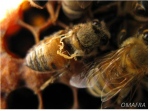 Feeding honey bees double stranded RNA can protect them against a destructive bee virus linked to colony losses Feeding honey bees double stranded RNA can protect them against a destructive bee virus linked to colony lossesScientists at the University of Manitoba have found that double stranded RNA can be used to protect honey bees from a widespread virus that is believed to be contributing to catastrophic colony losses, according to a new study published online in Insect Molecular Biology.
“Deformed Wing Virus, or DWV, is a common virus affecting bees which is linked with severe winter mortality in bee colonies. Having a means to prevent or suppress expression of the virus would be a valuable addition to our bee health toolkit,” says Suresh Desai, a Ph.D. student in Rob Currie’s lab at the University of Manitoba’s Department of Entomology and lead author of the study.
The DWV virus is often associated with the parasitic mite Varroa destructor, which can easily spread the virus between bees. Bees infected with DWV are typically discoloured and have shrunken or crumpled wings, and die soon after they emerge as adults. Some bees may not show any physical symptoms, but they lack vigour and die prematurely.
New RNA-based technologies promise to change all that. RNA interference or “silencing” is a revolutionary approach to treating disease in humans and animals. To suppress a virus such as DWV, RNA from the virus is replicated, converted to double stranded RNA (dsRNA), and then introduced to the host. The dsRNA acts to silence the viral RNA in the host cell, effectively blocking expression of the virus genes.
RNA interference has already shown some potential against other bee pathogens, including Israeli Acute Paralysis Virus and the microsporidian Nosemae ceranae. To test if the technique would be effective against DWV, Desai and colleagues fed dsRNA prepared from the virus to honey bee larvae and adults before infecting them with the DSW virus in the laboratory. Adult bees which received the dsRNA treatment lived longer and had lower viral loads than control bees not inoculated with dsRNA. Larvae fed dsRNA had reduced viral loads and fewer incidences of wing deformity when they emerged as new adults. Although the dsRNA treatment did not increase the survival of larvae, the improvements in viral load and adult longevity may offer a significant boost to overall colony health.
The researchers note that DWV dsRNA was absorbed through the bee gut and transported to other tissues. “This means that the dsRNA treatment could be easily applied to colonies through sugar syrup feeders, an effective and convenient way to reduce the stress on colonies associated with DWV and potentially other virus infections as well,” says co-author Currie. “With no single cause identified for ongoing colony losses around the world, it is important that we mitigate what stresses we can.”
Desai SD, Eu Y-J, Whyard S, Currie RW (2012) Reduction in deformed wing virus infection in larval and adult honey bees (Apis mellifera L.) by double-stranded RNA ingestion. Insect Molecular Biology (first published online: 12 June 2012; DOI: 10.1111/j.1365-2583.2012.01150.x)
See Attached files here:
| 